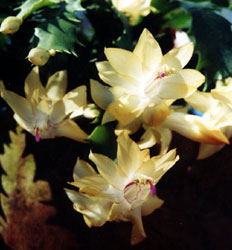 | Schlumberger (Schlumbergera) is an epiphytic cactus from the Cactaceae family. In nature, there are 5 species. Homeland - the rainforests of South America. Indoor conditions, two species are more often grown - Schlumbergera Buckleyi and Schlumberger Truncata Schlumbergera truncata. This cactus blooms for the New Year, the peak of flowering falls on Christmas, for which it was christened the Decembrist and Christmas cactus. The Schlumberger genus, named after the surname of the famous cactus breeder Frederick Schlumberger, combines low epiphytic cacti with jointed shoots, at the ends of which red-colored long-tubular, often asymmetrical flowers appear from the apical areoles. This structure distinguishes Schlumberger from the closest relatives of the genus Ripsalis, the flowers of which are funnel-shaped or star-shaped, appear along the entire length of the segment. |
Question: For some reason, the Decembrist does not bloom. What's wrong?
Answer: If the Decembrist does not bloom at all or forms single flowers, it means that the conditions of care are not met or they are violated. The main reason for the lack of flowering is insufficient light and lack of nutrition. The absence of formative pruning can also affect, since flowering occurs on young segments. If the plant has not been transplanted for a long time, the soil has become very compacted and depleted, flowering may also be absent.
Question: My Decembrist's leaves are crumbling. What can be done?
Answer: Drying and shedding of flattened stems (these are not leaves) occurs in two cases - with waterlogging and with overdrying of the soil. If the soil is dry, the problem can be solved by regular watering. But if the soil is waterlogged, then the Decembrist will have to be transplanted. The plant has a very weak root system that is sensitive to the amount of water - if there is more water than needed, the roots easily rot.
When transplanting, use any drug that stimulates the growth and development of roots - add it to the soil and add it to the irrigation water within 1-1.5 months after transplanting. Spray the plant with water at least 3-4 times a day. Place the plant pot in the brightest spot, but avoid direct sunlight.
Question: After airing, I discovered that the leaves turned red and became soft. Is the plant dead?
Answer: If, during airing, the Decembrist fell under a stream of cold air, there was a strong hypothermia of the stems and the root system. This is indicated by redness and softening of the tissues. If the lower segments near the ground have not suffered much, there is hope for resuscitation. It is necessary to cut off the affected parts of the stems to healthy or less affected areas, spray and water the Decembrist with a solution of the Zircon preparation (2 drops per glass of water), avoiding waterlogging of the soil.
If no living parts are observed, the Decembrist, most likely, will not be able to reanimate.









